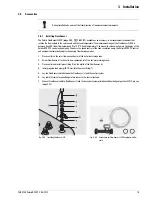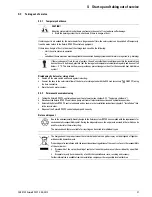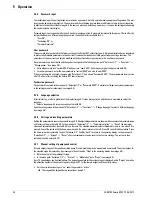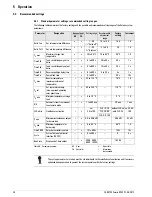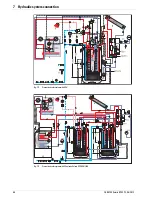
5
x
Operation
31
FA ROTEX Solaris RPS3 P2 - 06/2012
5.2.6 Speed control of the P1 tank circulation pump
After the start sequence the Solaris R3P control systems initiate the following:
– Stepwise output reduction of P1 until the calculated nominal spread "DT" maintains the setpoint value corresponding to
image 5-3, or until it falls below the minimum flow V2 (image 5-4).
– The switch to the next pump stage is implemented after a safety time "t
2
" (image 5-4).
If the pump output is too low, the flow in the solar panel circuit may be interrupted depending on the system or the temperature.
If the flow falls below the value "V2" for at least 10 s (image 5-4), the control systems detect a flow interruption, and the last
valid output stage is saved as the minimum pump output. Lower pump output stages are blocked.
The temperature-dependent output control of P1 is between the calculated minimum and maximum output. The spread of "T
V
"and
"T
R
" is continuously measured and compared with the nominal spread. If the temperature spread between "T
V
" and "T
R
" is too
great, the pump output of P1 (max. 10 stages) and therefore the flow through the solar panels is increased until the nominal
spread is reached. If the spread is too low, the pump output is reduced. The actual pump output of P1 while it is running is
displayed as a percentage in the "Flow" indicator beside the measured flow value. A typical operating sequence of a modulating
solar system is shown in image 5-3.
Fig. 5-4
Example for modulation operation with flow-caused block of low pump stages on systems with FlowSensor
DT
Set temperature difference (calculated for
operating point)
S1
Upper set temperature difference
("temperature difference 1")
S1
Lower set temperature difference
("temperature difference 2")
T
K
Collector temperature
T1
Minimum temperature of storage tank ("T
R
min")
T2
Booster temperature ("TK max")
T3
Switch-on inhibit temperature ("TK zul")
—
Nominal spread
---
Switching limits for pump modulation
Fig. 5-3
Temperature difference-dependent pump output control
A
Start phase
B
Operating phase (modulation)
C
Interrupted flow
D
Low pump output stages are automatically disabled
when flow is interrupted
V
Solar circuit flow
V1
Minimum flow in start phase ("VS min")
V2
Minimum flow in operating phase ("S flow")
t
Time
t
1
Maximum start run time of tank
circulation pump ("Time PsE")
t
2
Stabilisation period ("S time")
t
3
Interruption detection period (10 s)



